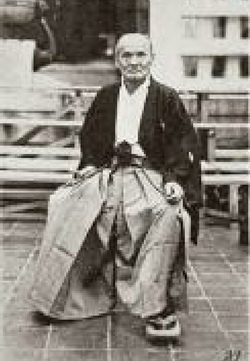


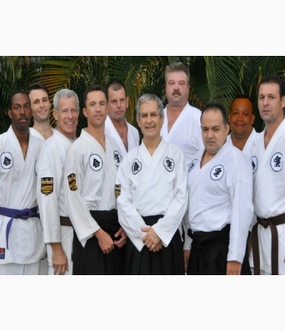
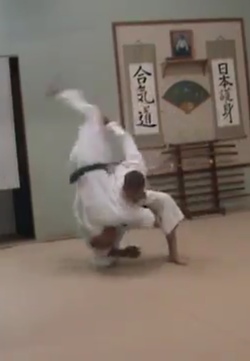

Inside Nihon Goshin Aikido ~ #24
March 5, 2015
In This Issue:
- Disrupting Uke’s Balance: Effortless Aikido and the Tenshin Movement ~ How Do You Marry an Attacker’s Striking Intention with His Nearly Immediate Arrival On the Pavement?
- Jim Giorgi Interview: Here is an excerpt from our interview in which we discuss his book, “Integral Aikido,” and many other items of interest to the Nihon Goshin Aikido Aficionado ~ A Must Read!
- The Ultimate Aikido Demonstration on Youtube ~ I’ll Take You There!
- The Problem with Language ~ Standardizing Movement Vocabulary, Should We Do It?
- NGA Seminars this month in Greenville, SC & Fort Lauderdale, FL (Win a Free NGAexperience.com T-shirt by attending!)
- Recent Student Promotions!
- Growing Our Subscriber Base ~ Please Forward to your Friends and training buddies
- Announcements: Got a rank promotion, opening a new dojo, hosting a seminar, etc.
1. Effortless Aikido and the Tenshin Movement: How to Marry an Attacker’s Striking Intention with His Nearly Immediate Arrival On the Pavement?
Effortless Aikido ~ just what we want, right? More and more I’m trying to look at aikido through the lens of a lazy man. The general idea is pretty simple: “Just get out of the way, and let uke fall down nearly all by himself.”
So what is the secret to effortless aikido? If I could be so presumptive to point you in a direction, I would say, the secret is contained in your very first movement ~ which is never confrontational, but always breaks uke’s balance, and allows powerful technique to flow forth without effort.
Now Nihon Goshin Aikido Aficionados that we all are, we certainly know a thing or two about breaking uke’s balance. Consider your earliest remembrance of the Elbow Chop. In the “This is how you do it” explanation, you’ll remember your sensei pointing out that “with proper distance between uke and nage, all nage has to do to disrupt uke’s balance is simply raise his gripped hand.” (Premise tested: “The essence of effortless technique is the first movement”).
This simple, effortless motion of raising your gripped hand like you’re raising a sword, pulls uke’s weight slightly forward onto his toes (thereby unbalancing him), allowing the rest of the technique to flow effortlessly.
When you get good at the Elbow Chop, it becomes a single, smooth engine of destructive energy. All at the same time, you raise your arms and drop your one point, as you begin to drop back into an extended hamni. The snap of your hips to turn your orientation a full 180 degrees is perfectly timed to match your chopping hand’s contact with the inside of uke’s elbow as you establish extended hamni. All this effects the launch. Now when you get to this point, you’re done, because uke is simply no longer attached to the earth’s surface. Sure, you’ll catch a glimpse of him flying by your shoulder, and then he’ll hit the mat in front of you an instant later ~ sometimes longer. That is it. That is kuzushi (Balance breaking), and what follows forth is powerful technique; in this case the Elbow Chop Classical Technique.
Now the Tenshin movement accomplishes the same balance breaking idea also allowing powerful effortless technique to devastate uke, but there is a key difference. With a Tenshin movement, uke’s balance is broken in a different direction relative to nage ~ which is why it is of particular interest to me. Unique to the tenshin movement, uke’s balance is broken directly in front of nage.
So let’s discuss particulars. I’ve done my best to document the movement in Microsoft Paint. So consider my crude footwork drawing to the left. The black feet represent Nage’s initial stance. The gray feet are nage’s finishing stance. The red arrow is the intention of uke’s strike. As you can see, the right foot is moved first (slightly back and directly away from the strike), and then the left foot is drawn back into a left hamni. Your finishing position is slightly back and offline. Now if you move into tenshin correctly, uke will be completely off balance and his kuzushi will be so badly disturbed that he will even occasionally just crumple at your feet if you only pull uke’s striking hand into your center. Uke Down ~ Fight Over.
To my eye, the movement most closely resembles the footwork for the Reverse Wrist Technique (and the distance between uke and nage at the finish are similar), but even the casual observer will note that the footwork is notably different. In the Classical Technique of the Reverse Wrist, when moving to your right, the footwork would have you finish in a right hamni stance, but as you can see in the tenshin movement, the footwork places you in left hamni (the exact opposite stance).
As I said, “it’s similar, but still different.” This is NOT an accusation. By all means, if anything I see the understanding of the Tenshin movement as an opportunity.
The tenshin movement adds another arrow to your proverbial aikido quiver ~ a way to send uke flying off in a “new and unexplored” direction using the same trusty 50 techniques we’ve always used! Variety ~ it’s the spice of life.
Now how does it work? Well, I’ve attached a video that demonstrates the Tenshin blending movement in reaction to various strikes (mostly round, but not always). Lots of applications of our 50 techniques follow from that initial tenshin movement. Rather than focus on the implementation of technique however, focus instead on the first movement and how that tenshin movement leads to uke’s kuzushi which makes effortless technique possible.
Pay close attention to how disturbed uke is as the energy of his strike is carried past the point of his original intention due to nage’s tenshin blend. In my mind the tenshin blend does not simply disrupt uke’s balance, it destroys uke’s balance.
Give Credit Where Credit is due:
Sensei Darrell Tangman (aikikai) out of Augusta, GA showed me the Tenshin movement last December on one of his regular trips to Columbia, and I remember thinking, “I need to remember this concept.” It was such a unique movement to me initially, in that it felt completely foreign.
In fact, Sensei Lamar Sanders (aikikai) showed the same concept to me probably a year prior, but I just could not get it in my head at that time ~ so in my second experience, I felt like I had to get it right.
My best understanding of the tenshin concept to date has been worked out with Walter Patterson (aikikai) over the last few months. All good men and very helpful, despite their aikikai leanings ~ lol ~ but I’m an evangelist for our art. While I have breath, there is hope for their conversion. ;)
What say ye?
2. Building on the idea of Integral Aikido, leading to effortless power and technique, here is an excerpt from my interview with Sensei Jim Giorgi.
Sensei Giorgi On Technique:
I strive NOT to choose a technique, but simply get to the right spot as I unbalance uke, and then let the technique choose itself.
That is the most important point for me right now.
You can know a myriad of techniques but if you are not in the right place at the right time, you won't be successful using any of them.
I want to share with you my story of the gift of the Katana as a way to demonstrate what I am teaching about being in the right spot.
I held an aikido seminar at my dojo in Ft. Lauderdale a while ago. My teacher came down from NY and a lot of visitors were there from other Nihon Goshin Aikido dojos, including Dave, a black belt from the NGA dojo in Georgia, whom I have taught whenever I was there for seminars over the past 9 years.
The Monday after the seminar, I taught my usual aikido class and Dave, who was still in the area, attended. After class he came over to me.
"I have something for you," he said.
He went to his car and came back into the dojo with a box about 45 inches long. He opened it there in the dojo and handed me a genuine katana.
A samurai sword. Not a dangerous reproduction made of brittle stainless steel... a real one with a razor-sharp blade of carbon steel.
He gave it to me and said, "This is a gift for all the years I have known you, and all the years I have been your aikido student, to show my appreciation for our friendship."
Being a martial artist, having practiced for more than a quarter of a century, one would think that I would have the accoutrements of a martial artist, but things have never been that important to me.
Always in the back of my mind though was an idea that ‘someday I might have a genuine katana .. razor sharp. Sharp enough to cut through bamboo, through watermelons, or even cut off heads!’
The idea of owning a real sword would rise and fall, maybe once every month or two, if that often.
The intention of my desire was almost not even set. A thought, every so often an image of a genuine katana, then I would let it go as easily as it arose. To buy one, to have it, for it to sit on a shelf... none of this was important.
Then that intention eventually worked itself out. With no effort at all. Absolutely no effort on my part, and one day, a razor sharp katana blade unexpectedly materialized in my world ~ delivered by one of my own students; a friend of many years.
In many ways my theories on unbalancing uke are similar to my experience of intention with the katana.
It just seems to me the more I think on it, that the more you “try” to muscle uke over with some preconceived notion of technique, the less likely your technique is going to work as powerfully as it might should your focus be different.
So let go of your desire to execute technique, and just focus on getting into the right place at the right time. If you do so, nearly miraculous power will emanate, and you will have the effortless power to throw uke in any direction that pleases you.”
Click here to read this facinating interview in its entirety.
3. I have found the Ultimate Aikido Demonstration on Youtube!
Now I’m not sure how many aikido videos are posted up on youtube.com, but I submit they would number in the 50 thousands, or more. That said, I must say that I think the best presentation of the art on youtube currently is the video from the 2013 World Combat Games which were held in St. Petersburg, Russia.
During the multi-day event, Aikido had a 1 hour and 40 minute demonstration. Cut for a television broadcast, the demonstration was professionally filmed, and commentated by an Australian Aikido sensei. It featured representatives from various dojos, and organizations across the globe.
I am completely sincere when I say that this video is possibly the finest video of the art available on the web in terms of the quality of the footage, ability of the practitioners, and the completeness of their demonstrations.
Now as to the format of the World Combat Games Aikido demonstration: every demo team from each nation was given a single attack to demonstrate (eg: a jacket grab, or a 2 hand grip from the rear, or a shomenuchi, etc.). Then they demonstrated as many techniques as they could within their allotted time constraints. The result of the single attack repeated over and over was a ton of creativity, and cleverness, as the easy applications were quickly exhausted, and new applications for mastery abound throughout the video as a result.
So, if you’re feeling a little stale in your applications, this video is just what you need. Watch it once a week, for a year, and I promise that you’ll see something different and appealing every time.
You can access the video link to the entire One hour and 40 minute demo by clicking here.
4. The Problem with Language is that few can ever agree on actual definitions. Standardizing Movement Vocabulary; is it something to consider?
Now that’s a question with a thousand potential answers, and there is a tome of pages written on aikido movements (and even more meaningful video), so I will not replicate them here.
That said, generally speaking, each aikido movement has a unique Japanese name, but I’ve noted that the movement names we use in our style (which are Japanese names) describe movements which often have very different names in other aikido styles. Since these other organizations operate exclusively in the Japanese vernacular and we don’t, I wonder if it might make sense to defer to their names or descriptions?
It seems that having different names for the same aikido movement presents a potential for significant confusion as we seek to communicate our ideas to the greater aikido community, and grow our art.
With the idea of growing our art first and foremost in my thoughts this past month, I sought to develop a way to somewhat standardize our communication on movement so that our vocabulary generally runs consistent with the other aikido arts. Feel free to disregard the notion. This is more of a “thinking out loud” exercise than anything else. Still if you’d like to read my ideas, or note my observed inconsistencies, the article on this concept is here in a somewhat rough format, but with some picture and video evidence.
5. Seminars:
We have 2 seminars coming up this month. All affiliations are welcome.
March 27-28 Fort Lauderdale, LF
~ Who is the Ironman who can make them both? Email me selfies of you (with the seminar instructors) at both seminars, and I’ll send you a free NGAexperience.com
t-shirt!
6. Nihon Goshin Aikido Promotions:
Here are three promotions from the Nihon Goshin Aikido Dojo in Greer, SC
Promotion to Go-Kyu:
Daniel Reter Jr. to Go-Kyu, 01/30/2015
Nathan Burin to Go-Kyu, 02/24/2015
Promotion to Ni-Dan:
Daniel Rester to Ni-Dan, 03/01/2015
Join me in extending a hearty congratulations to these NGA Aficionados!
7. Newsletter Subscribers:
More subscribers is the goal ~ so can you help us grow our Newsletter Subscription Base by passing the website along to your training buddies and asking them to subscribe?
Our hope is to be an inter-dojo clearing house for all things NGA, but we need more subscribers to do that. Best of all, it’s free, and who doesn’t like the word “free!” Click Here to Subscribe! (And make sure your forward to all your training buddies, and would be training buddies).
8. Announcements:
Do You Have News On Seminars, Dojo Expansions, Relocations, Grand Openings, Promotions, and/or Other Information You Want To Share? Send us the information on it and we’ll post it here for you.
Let's meet on the mat together soon!
Best,
Jonathan Wilson
ngaexperience.com

2014 - 2021 ngaexperience.com

In this picture, it is pretty clear that I have disrupted uke’s balance. Great breakfall Tito Garcia!
Unless otherwise stated, the author’s views, musings, and opinions do not necessarily reflect the attitude of leadership within any of the various Nihon Goshin Aikido associations, or unaffiliated Nihon Goshin Aikido dojos.
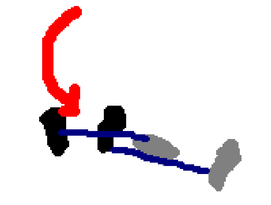
The Tenshin Movement: A movement back and off line. Offering tremendous kuzushi opportunities, the Tenshin movement works especially well against round attacks.

Jim Giorgi (c) with students from his Fort Lauderdale, FL dojo.

The Tenshin Movement demonstrated.
Note how nage controls uke’s striking hand past the center line and into kuzushi.
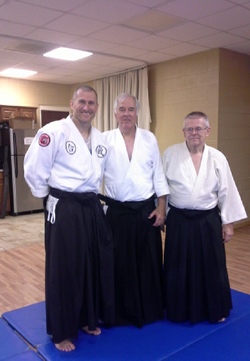

Tenshin Movement Night This is me with Sensei Sanders (c), & Sensei Tangman (r)


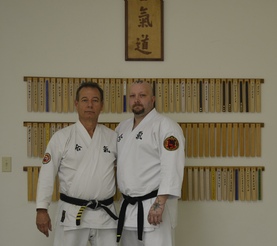
Shihan Weber and
Sensei Rester after his promotion to ni-dan.
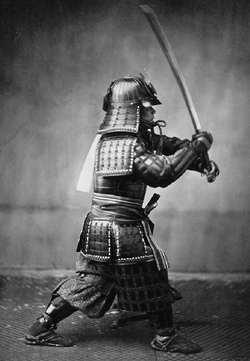

Though compelling in its own right, this picture has nothing to do with the Aikido Demonstration discussed on the right.
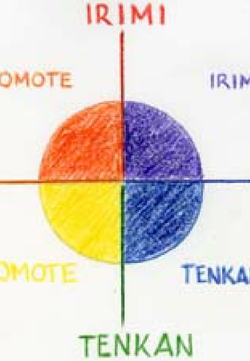

Is standardization of vocabulary of movement worth the effort in our attempt to grow the art?
The Tenshin Movement

